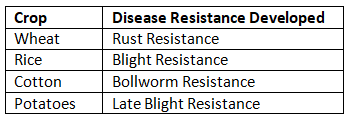Breeding for Disease and Pest Resistance | Agriculture Optional for UPSC PDF Download
Plant Breeding for Disease and Pest Resistance
Plant breeding for disease and pest resistance is a vital aspect of agricultural science aimed at enhancing crop productivity and reducing the reliance on chemical interventions. In this article, the methods and advantages of breeding for disease resistance and resistance to insect pests will be discussed, shedding light on the importance of these practices in ensuring a sustainable food supply.
Plant Breeding for Disease Resistance
Crops are susceptible to a myriad of fungal, bacterial, and viral pathogens, especially in tropical climates. These pathogens pose a significant threat to crop yields. However, the genetic makeup of the host plant plays a pivotal role in determining its resistance to these pathogens.
Plant breeding for disease resistance offers several advantages, including:
- Enhanced Food Production: Disease-resistant crops exhibit a higher yield potential, reducing losses due to diseases. This is a critical factor in meeting the global demand for food.
- Reduced Chemical Dependency: By developing resistant crop varieties, the need for fungicides and bacteriocides is diminished, promoting sustainable and eco-friendly agriculture.
The primary culprits responsible for plant diseases are fungi, bacteria, and viruses. Some examples include brown rust of wheat, red rot of sugar cane, and late blight of potatoes caused by fungi; black rot of crucifers, blight of rice, and citrus canker caused by bacteria; and tobacco mosaic and turnip mosaic caused by viruses.
Methods of Breeding for Disease Resistance
Two main methods are employed for breeding disease-resistant crops:
- Conventional Breeding: This method, practiced for centuries, involves the selection and screening of germplasm for disease resistance. It includes hybridization of selected plants, evaluation of hybrids, and the subsequent testing and release of new disease-resistant varieties into the market. Conventional breeding, while widely used, has limitations, primarily the identification of a limited number of disease resistance genes in crop varieties and their wild relatives.
Table: Important Varieties Developed by Conventional Breeding Disadvantages of conventional breeding: Limited number of disease resistance genes have been identified in crop varieties or wild relatives.
Disadvantages of conventional breeding: Limited number of disease resistance genes have been identified in crop varieties or wild relatives. - Mutation Breeding: This method harnesses genetic variation by artificially inducing mutations through chemical or radiation exposure. The process involves inducing mutations, screening plants for desirable traits, and selecting the most suitable plants for breeding. Mutation breeding is a promising approach, especially when disease resistance genes are scarce in crop plants and their wild relatives.
Table: Examples of Disease Resistance through Mutation Breeding
Plant Breeding for Developing Resistance to Insect Pests
In addition to disease resistance, breeding for resistance to insect pests is essential for crop protection. Pest resistance in host crop plants can be attributed to various characteristics, including hairy leaves, solid stems, and specific biochemical compositions. These traits deter pests and contribute to sustainable agriculture.
The breeding methods for insect pest resistance are akin to those used for other agronomic traits, encompassing hybridization and selection processes.
By employing these methods, plant breeders and agricultural scientists are continuously striving to develop crops with enhanced disease and pest resistance. These efforts are pivotal in ensuring food security, reducing environmental impact, and promoting sustainable agricultural practices.
|
52 videos|224 docs
|
















